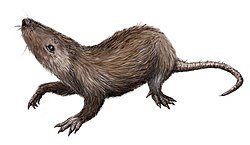| Essonodon Temporal range: | |
|---|---|
| Scientific classification | |
| Domain: | Eukaryota |
| Kingdom: | Animalia |
| Phylum: | Chordata |
| Class: | Mammalia |
| Order: | † Multituberculata |
| Family: | † Cimolomyidae |
| Genus: | † Essonodon Simpson, 1927 |
| Species: | †E. browni |
| Binomial name | |
| †Essonodon browni Simpson, 1927 | |
Essonodon is a mammal genus from the Upper Cretaceous of North America. It was a member of the extinct order Multituberculata and lived towards the end of the "age of the dinosaurs." It is within the suborder Cimolodonta and perhaps the family Cimolomyidae. It contains a single species, Essonodon browni, formerly also known as Cimolodon nitidus (Marsh 1889).
The genus Essonodon was named by Simpson G.G. in 1927, and is also partly known as Cimolodon . The inclusion of this taxon within Cimolomyidae is tentative. (Kielan-Jaworowska & Hurum 2001, p. 408).
Fossils are known from the late Campanian to the end of the Maastrichtian. They are known from the Hell Creek Formation of Montana & North Dakota (USA), the Frenchman Formation of Saskatchewan (Canada), and the Fruitland & Ojo Alamo Formations of New Mexico (USA). [1]
This species was a relatively large multituberculate that weighed around 1.18 kilograms. [2]


